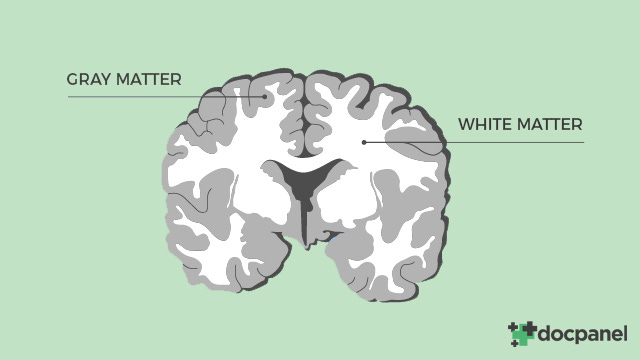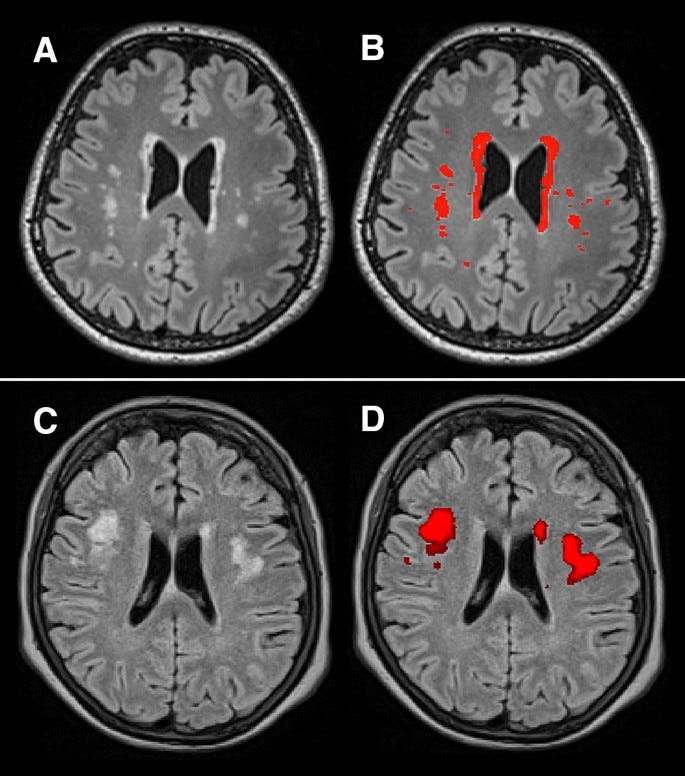Another football season has ended and, of course, the topic of concussion, TBI, and CTE came up on more than one occasion.
We are often most concerned with symptomatic concussions, that is, head injuries like helmet-to-helmet, helmet-to-ground, or even whiplash injuries which cause neurological dysfunction and concussion symptoms.
But not every head injury causes symptoms. Neurologists use a term called Repetitive Head Impacts (RHI) to include both symptomatic AND asymptomatic brain injuries.
Well, how do repetitive head impacts really affect the brain later in life? Recent research has cast a light on the serious long-term outcomes that repetitive head injuries in sports, particularly football, have on athletes' brains.
A study led by Dr. Monica Ly delves deep into how these impacts associate with white matter hyperintensities in former American football players.
White matter hyper-intensities are, for lack of a better term, bright spots in the brain's white matter. What is white matter? White matter is the part of the brain that has the long wires traveling through it. Your brain has billions of little computers, most of them talk to next-door neighbors. If a computer on one side of the brain needs to talk to a computer on the other side, it has to send a long wire across the brain through the white matter.
Now, people with long-standing chronic medical issues such as hypertension/high blood pressure, diabetes, high cholesterol, history of smoking, sleep apnea, even migraines can develop these bright spots in the white matter. Individually, we don't think these individual little bright spots necessarily do much, but cumulatively over time, they are definitely associated with things like cognitive decline and dementia.
So in this study involving 180 former football players, they used advanced imaging techniques and biomarker analysis to understand the link between repetitive head injuries and white matter hyperintensities. The study found that greater exposure to repetitive head injuries was associated with increased white matter damage on brain MRIs.
This relationship was particularly pronounced when looking at players' vascular health and biomarkers such as phosphorylated tau, which is a protein often associated with neurodegenerative diseases such as Alzheimer's. The study found that higher levels of vascular risk factors and phosphorylated tau were directly linked to increased white matter hyperintensities in these athletes.
The study has several limitations.
It was really a relatively small and specific sample of former elite football players which might limit the generalizability of the findings.
It's also called a cross-sectional study, which means that it can only show associations at one point in time rather than a causal relationship over time.
The study relied heavily on imaging and biomarkers without direct correlation to clinical outcomes. So while imaging can show physical changes in the brain, it does not necessarily correlate with changes of cognition or behavior.
Lastly and most importantly, it's impossible to know exactly how many repetitive head impacts somebody's had in their life. The authors used proxy measures such as years played and player position, to estimate RHI. These proxies might not accurately represent the actual biomechanical forces experienced by the brain.
Regarding chronic traumatic encephalopathy (CTE), the study does address this question, but with limitations. While it correlates biomarkers like phosphorylated tau associated with CTE with white matter hyperintensities, the study does not confirm the presence of CTE directly. That's because the only way to really diagnose CTE is post-mortem when you look at the brain under a microscope. Instead, the study suggests that certain biomarkers linked to CTE might also be associated with these white matter hyperintensities in living players. That supports the hypothesis that repetitive head impacts could contribute to brain changes indicative of potential neurodegeneration years down the road.
My big takeaway from this study is that we need to focus not just on symptomatic concussions, we also need to focus on the burden of repetitive head impacts in a person or an athlete's life. It's not just the symptomatic head injuries that could be affecting somebody's cognition years down the road, but it could be the asymptomatic repetitive head impacts that happen over and over and over again in practice, in training, in games, without players even having symptoms or even knowing that their brain is being assaulted.
Now, like every neurologist who talks about sports and concussions, I will probably be accused of wanting to end sports.
I'm not advocating we shut down football.
I'm not advocating we shut down the NFL.
I'm not advocating that we shut down youth sports across this country.
There's obviously tremendous benefit for our children and our young adults and our adults to be able to engage in physical activity, competitive activity, and team sports. I think it would be really interesting to reproduce this study in non-football players like former athletes from soccer, hockey, baseball, gymnastics, and even cheerleading.
I hope you enjoyed this episode. If you have any questions, comments, please engage. Leave the comments below. Follow along. I'll be reviewing more papers and more topics in neurology. If there are things you want me to cover, please let me know. And I look forward to talking to you again next time.













Share this post